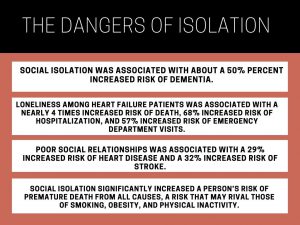Life is full of decisions to make, and the number of decisions we have to make does not decrease as we get older, nor do the decisions get less consequential. In fact, one of the biggest choices you’ll have to make is how to spend your old age: are you going to consider moving into an assisted living facility, will you have family to live with, or are you hoping to be able to “age in place,” or keep living in your own home for as long as possible?
While it’s not always possible to make this decision on your own, depending on your health, it is a decision that you should have as much of a say in as possible. And if you’re like the majority of seniors nowadays, your preference is probably to stay put, for multiple reasons. But is there a downside to aging in place? As with anything, there are certainly pros and cons, but one major con to consider is the toll that aging in place can take on your mental health if you live alone, which can lead to feeling socially isolated. So does this downside negate the positive aspects of aging in place, or are there ways to combat this social isolation?
The Desire to Age in Place
What is aging in place? According to the CDC, this means “the ability to live in one’s own home and community safely, independently, and comfortably, regardless of age, income, or ability level.” Sounds good, right? That’s probably why, as we mentioned above, if your goal is to age in place, you’re certainly not alone. In fact, a survey by the AARP has found that 77% of adults over 50 plan to stay in their homes for the long term, and that’s on the lowest end of the spectrum. Most surveys tend to show that 90% of older adults want to stay in their own homes as they age.
According to Martin Lenoir, chief marketing officer at American Advisors Group (AAG), which did a survey on how meaningful “the home” is to seniors, “For seniors, the comfort, safety and independence of their home outweigh the desire to move.” In fact, AAG found that:
- Over 90% of seniors prefer to remain in their homes as opposed to moving into an assisted living facility
- 82% have no concrete plans to ever sell their home or move away
And why is this? According to this survey:
- 83% of respondents stated they feel safer at home compared to elsewhere
- 40% said their independence is the most important benefit of aging in place
- More than 50% of seniors have an “emotional attachment” to their home because it reminds them of their family
Studies have also found that aging in place can promote life satisfaction, a positive quality of life, and self-esteem, all of which are needed to remain happy, healthy, and well into old age. But as mentioned above, there can be a dark side to staying at home.
The Dangers of Isolation
Aging in place can often mean living alone at some point; in fact, nearly one-third of all seniors live by themselves, according to the U.S. Census Bureau. That’s close to 14 million seniors aging alone. And while living alone is not problematic for some older adults, it can lead to loneliness – generally around 40% of seniors report feeling lonely, with that number rising to well over 50% in 2020 during the pandemic – and even isolation-induced depression.
And it isn’t just the actual living alone that can be a problem for older adults, it’s the perception of loneliness and isolation (remember: loneliness doesn’t refer to being alone, rather it refers to feeling alone). As you age, it can be harder to get out to do the things you want to do, you might have lost a spouse who was your confidante, or family might be further away than you’d like them to be.

These feelings of social isolation and loneliness can actually put your health at risk. Recent studies have found that:
- Social isolation significantly increased a person’s risk of premature death from all causes, a risk that may rival those of smoking, obesity, and physical inactivity.
- Social isolation was associated with about a 50% percent increased risk of dementia.
- Poor social relationships (characterized by social isolation or loneliness) was associated with a 29% increased risk of heart disease and a 32% increased risk of stroke.
- Loneliness was associated with higher rates of depression, anxiety, and suicide.
- Loneliness among heart failure patients was associated with a nearly 4 times increased risk of death, 68% increased risk of hospitalization, and 57% increased risk of emergency department visits.
Those are some very dire statistics, but they don’t mean that you should give up on the idea of aging in place. If you’re physically able to stay home, the sense of independence, and the connection to the memories in your family home, can make staying put totally worthwhile. And there are ways to combat loneliness, social isolation, and all of the negative consequences that can come with those psychological impacts of living alone.
How Older Adults Can Avoid Social Isolation
If you’re aging in place, and living alone (or even if your spouse is still living with you, and you need more socializing), there are ways to combat loneliness. For example:

Reach out
This is something that you’ve heard before, but it’s worth saying again: the first step to combating loneliness is to reach out. Have friends stop over, keep up with your neighbors, and set up a weekly time for grandkids or other close contacts to stop by for a visit.
Consider a roommate
Sure, your college days are over, but there’s no reason why you can’t buddy up in your older age. In fact, seniors taking on roommates is a growing trend in the U.S., as more people are looking for help with the rent or mortgage, as well as companionship. And don’t worry, you don’t have to rely on placing an ad and hoping for the best: there are actually services that safely and effectively match up older adults with roommates.
Get some help around the house
If you need a helping hand, don’t hesitate to look into an in-home caregiver. They can provide practical assistance with things like meal prep, housekeeping, and transportation (so you can get out of the house more!), but they can also provide companionship, as well.
Give back
Now that you’ve got more time on your hands, and you’re looking to spend some time with others, it’s the perfect time to consider volunteering. Local libraries, museums, schools, animal shelters, gardens, etc all need help, so whatever your interests you should be able to find a way to get involved in your community and meet new people.
Share your interests
Whatever your hobbies, try to find others who share them – and don’t be shy about telling your loved ones about them. They’ll be interested to know what makes you happy, and might want to join in so you can spend time together.
Get moving
Joining an exercise class is a great way to get out and meet people, as well get healthier and give yourself a shot of all those mood-boosting endorphins, making working out a win-win-win situation!
Be a joiner
Look into your local senior center, which probably has classes and activities geared towards older adults. You can meet people with similar interests, and learn something new!
Know your transport options
If you’re still driving, great! But if that’s not something you’re as comfortable with now that you’re getting older, make sure you know your options. Public transport can really be your friend (and many cities offer free bus passes for seniors), but if you live somewhere without as many public options, set up an account with a ride-sharing app like Lyft, or look into local senior centers, which sometimes offer transport for older adults.

Embrace technology
If you can’t see your family and friends in person as much as you’d like, remember that you can see them anytime you like with the help of modern technology! Get yourself a smartphone or tablet and install an app like WhatsApp, which has a super easy video calling function, and your loved ones will be literally in your pocket and right there at your fingertips! Sure, it’s not exactly the same as spending time in person, but if you’re not sure about it, consider this: studies show that older adults who use email, instant messaging or social media platforms like Facebook have about the same rate of depressive symptoms as those who do not use any communication technologies. But people who use video chat applications have almost half the estimated probability of depressive symptoms.
Find a balance
Remember, only you can determine what the “right” amount of socializing is for you. Your friends and family might be concerned about you spending time alone, and with the best of intentions, try to pack your social calendar. If that’s not what you need, let them know!
If you’re healthy and in the financial position to do so, aging in place can be a great option for keeping you feeling independent and in control as you age. You should absolutely be able to make this decision for yourself, but you also have to remember that avoiding social isolation needs to be near the top of your list of things to consider when thinking about what staying in your home as you age will look like. But with a good plan, some creativity, and a willingness to seek out opportunities, you’ll be able to ensure good mental health and continued social connections as you age in place.

